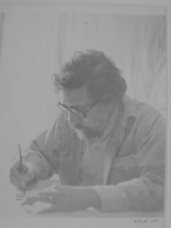About him
 Today, whereas artists tend to mix different media in the same work, Adli Rizkallah’s loyalty to watercolors is unique; he is a man of infinity in one medium. He is an artist who works solely with watercolors, yet he demonstrates an impressive diversity of approaches and superb technical prowess.
Today, whereas artists tend to mix different media in the same work, Adli Rizkallah’s loyalty to watercolors is unique; he is a man of infinity in one medium. He is an artist who works solely with watercolors, yet he demonstrates an impressive diversity of approaches and superb technical prowess. Rizkallah based his watercolor style on his own philosophy and techniques. His profound discoveries in watercolors are the fruit of his unusual use of the medium, of the size of his paintings, as well as of his endless research in and with watercolors. This medium experienced unprecedented evolution thanks to his ground-breaking contribution.
 His exploration of graphic techniques echoes the concerns of many artists from different cultures. His distinctive palette plays a central role in his paintings. The one-hundred-percent-cotton paper on which he works is fundamental to his research. Its texture, surface, thickness and various shapes are crucial to Rizkallah’s unique compositions and themes.
His exploration of graphic techniques echoes the concerns of many artists from different cultures. His distinctive palette plays a central role in his paintings. The one-hundred-percent-cotton paper on which he works is fundamental to his research. Its texture, surface, thickness and various shapes are crucial to Rizkallah’s unique compositions and themes.His concern with experimentation and urge for originality, as well as the individuality that drives his work, brought about new encounters, exchanges and dialogue. Contemplating his work evokes not only the whole story of our paper-based civilization, but also his unique understanding, appropriation and incorporation of two great civilizations, Arabic and Western.

His world is a weird blend of tangible matter and aesthetic fascination, of the spontaneity and strength of his brush strokes, colors and water. One can easily find oneself absorbed in Rizkallah’s world and themes. From Crystals to Pyramids, from Revival Flowers to Upper Egypt, from Sculptural to Symphonic watercolors, etc., his world can shake, shock, and even disturb us. Likewise, his different worlds carry us far away, entrance us and make us dream.
The artist considers his work as a continuation of the art of the first half of the twentieth century, and he chose to overlook the second half of the twentieth century, when art strayed from its path. Accordingly, though his work is not simply a part of the classical art of the first half of the twentieth century, it extends from this art that believed in the importance of human beings, and not in capitalism and consumer society. Rizkallah chose not to follow any art school in particular, yet he was deeply influenced and nurtured by the laws of abstract art, accidental art, cubism, lyric and visual arts, among other schools.
Rizkallah’s childhood was colored and marked by the very unique character of the harsh and rich nature of his native town in Upper Egypt. As an adolescent he had to work from the age of fourteen to support himself and to pay for his studies. He grew up to be a responsible and hardworking person. He dreamed of being a pianist but soon realized that this was not his fate, since the piano is an instrument of the wealthy. Meanwhile, his love for drawing and painting imposed itself upon him. He joined the University of fine arts in Cairo, where he acquired a solid academic education and background.
In the wake of the 1967 war, a defeat that changed the lives of all Arabs, Rizkallah settled in France for a while, seeking to escape the depression that followed that setback. He found his true voice in Paris, where he created his first watercolor painting after long years of research. Ten years later, he returned to Egypt never to leave again, determined to follow his inspiration and be guided by the essence of his work.

